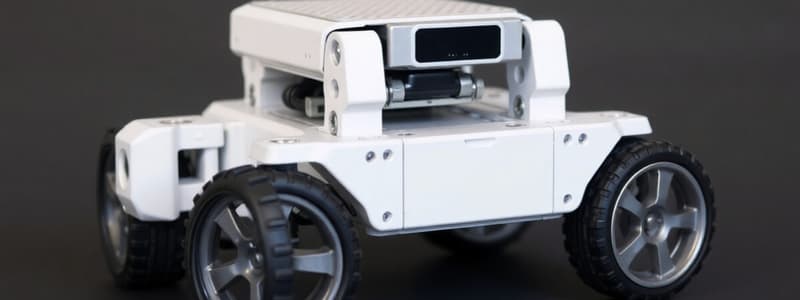Podcast
Questions and Answers
What is the main focus of the study of motion?
What is the main focus of the study of motion?
- Studying environmental impact
- Understanding robot design (correct)
- Building structures
- Analyzing human behavior
When considering motion from above, which aspect is being analyzed?
When considering motion from above, which aspect is being analyzed?
- Angular acceleration
- Translational force
- Linear speed (correct)
- Rotational movement
What term refers to the speed at which an object travels along a curve?
What term refers to the speed at which an object travels along a curve?
- Tangent speed (correct)
- Radial speed
- Curved velocity
- Lateral speed
Which of the following describes the angle at which an object moves?
Which of the following describes the angle at which an object moves?
In robotic design, what does the term 'linear speed' refer to?
In robotic design, what does the term 'linear speed' refer to?
What does the term 'angular velocity' refer to in the context provided?
What does the term 'angular velocity' refer to in the context provided?
What does the degree of movement depend on?
What does the degree of movement depend on?
Which factor can influence the angular velocity according to the provided content?
Which factor can influence the angular velocity according to the provided content?
If two wheels are aligned in the same direction, what can be inferred?
If two wheels are aligned in the same direction, what can be inferred?
What is the implication of a fixed position of rotation in a system?
What is the implication of a fixed position of rotation in a system?
Which scenario indicates the inability to steer effectively?
Which scenario indicates the inability to steer effectively?
What does the ability to tilt slightly around a defined point contribute to?
What does the ability to tilt slightly around a defined point contribute to?
What characteristic is not associated with two equal wheels in the context provided?
What characteristic is not associated with two equal wheels in the context provided?
What is typically true about the center of rotation?
What is typically true about the center of rotation?
In the context of steering capability, which factor is least likely to influence maneuverability?
In the context of steering capability, which factor is least likely to influence maneuverability?
Flashcards
Robot Construction Symbols
Robot Construction Symbols
Symbols used to design a robot.
Environmental Study
Environmental Study
Examining the environment.
Wheel Diameter
Wheel Diameter
The size of the wheel's diameter.
Linear Speed
Linear Speed
Signup and view all the flashcards
Angular Speed
Angular Speed
Signup and view all the flashcards
Constant Rotation Speed
Constant Rotation Speed
Signup and view all the flashcards
Lateral Wheel Movement
Lateral Wheel Movement
Signup and view all the flashcards
Center of Rotation
Center of Rotation
Signup and view all the flashcards
Steering Speed
Steering Speed
Signup and view all the flashcards
Rotation Level Changeable
Rotation Level Changeable
Signup and view all the flashcards
Vehicle's maneuverability
Vehicle's maneuverability
Signup and view all the flashcards
At least two wheels in the same direction
At least two wheels in the same direction
Signup and view all the flashcards
Equal wheels
Equal wheels
Signup and view all the flashcards
Freedom of movement
Freedom of movement
Signup and view all the flashcards
Driving skills
Driving skills
Signup and view all the flashcards
Study Notes
Locomotion
- Locomotion is the process of causing an autonomous robot to move
- Forces must be applied to the vehicle to produce motion
Wheeled Mobile Robots (WMR)
- WMRs are a combination of various physical (hardware) and computational (software) components
- Subsystems include:
- Sensing: measuring robot and environmental properties
- Locomotion: how the robot moves through its environment
- Control: generating physical actions for the robot
- Reasoning: mapping measurements into actions
- Communication: how robots and external operators communicate
Kinematics and Dynamics
- Kinematics: the study of motion without considering forces affecting it. It deals with the relationships between control parameters and the behavior of a system.
- Dynamics: the study of motion where forces are modeled. It deals with the relationship between force and motion.
Notation
- Posture: position (x, y) and orientation (θ)
- {XmYm}: moving frame
- {XbYb}: base frame
- q: robot posture in base frame
- R(θ): rotation matrix expressing orientation of base frame relative to moving frame
Wheels
- Rolling motion occurs along the y-axis
- Lateral slip occurs along the y-axis
- z-motion occurs along the z-axis.
Robot Wheel Parameters
- For low velocities, rolling is a wheel model
- Wheel parameters include:
- r: wheel radius
- v: wheel linear velocity
- w: wheel angular velocity
- t: steering velocity
Wheel Types
- Fixed wheel
- Centered orientable wheel
- Off-centered orientable wheel (castor wheel)
- Swedish wheel (omnidirectional property)
Examples of WMR
- Bi-wheel type robot: smooth motion, risk of slipping, sometimes uses roller-ball for balance
- Caterpillar type robot: free motion, complex structure, weakness of the frame
- Omnidirectional robot: free motion, complex structure
Mobile Robot Locomotion
- Instantaneous center of rotation (ICR) or Instantaneous center of curvature (ICC): cross point of all wheel axes
Degree of Mobility
- Degree of mobility: the freedom of robot motion
- 0: cannot move (no ICR)
- 1: fixed arc motion (only one ICR)
- 2: variable arc motion (line of ICRs)
- 3: fully free motion (ICR can be located at any position)
Degree of Steerability
- Degree of steerability: the number of centered orientable wheels that can be steered independently
- 0: no centered orientable wheels
- 1: one centered orientable wheel
- 2: two mutually independent centered orientable wheels
Degree of Maneuverability
- Degree of maneuverability (δM): δM = δm + δs
- δm: Degree of mobility
- δs: Degree of steerability
- Omnidirectional: δM = 3
- Differential: δM = 2
- Omni-Steer : δM = 3
- Tricycle : δM = 2
- Two-Steer: δM = 3
Non-holonomic Constraint
- Non-holonomic constraint: constraint on feasible velocities of a body
- Robot can move in some directions (forward, backward), but not others (sideways)
Types of Driving (Steering)
- Differential Drive: two driving wheels (plus roller-ball), sensitive to relative velocity
- Steered wheels: steering wheel + rear wheels, limited turn radius
- Synchronous Drive
- Omni-directional
- Car Drive (Ackerman Steering)
1-Differential Drive
- Posture of the robot: P = (x, y, θ)
- (x, y): position
- θ: orientation
- Control input: U = (v, w)
- v: linear velocity
- w: angular velocity
- (Notice: not for each wheel)
Motion Control
- Instantaneous center of rotation (ICR): (VR - VL)/L = VR/(R + L/2), R = L(VR + VL)/2(VR - VL). Radius of rotation
- Straight motion: R = infinity, VR = VL
- Rotational motion: R = 0, VR = -VL
2-Tricycle
- Three wheels, odometers on two rear wheels, steering/power via front wheel
- Control variables: steering direction (a(t)) and angular velocity (ωs(t)) of steering wheel
Synchronous Drive
- Motion of the robot is synchronised around the point of rotation.
4-Omnidirectional
- Swedish wheel can move in any direction
5-Car Drive (Ackerman Steering)
- Used in motor vehicles
- Inside front wheel rotates sharper than outside wheel
- Reduces tire slippage
Ackerman Steering
- Lateral wheel separation(d)
- Longitudinal wheel separation(l)
- Relative steering angle of inside wheel (θ1)
- Relative steering angle of outside wheel (θ0)
- Distance between ICC to center of vehicle(R)
- Cot(θ1) - Cot(θ0) = d/l.
Summary (Mobile Robot)
- Classification of wheels
- Fixed, centered, off-centered, Swedish
- Degree of maneuverability= degree of mobility + degree of steerability
- 5 types of driving methods
- Differential Drive
- Steered wheels (tricycle, bicycles, wagon)
- Synchronous Drive
- Omni-directional
- Car Drive (Ackerman Steering)
Studying That Suits You
Use AI to generate personalized quizzes and flashcards to suit your learning preferences.




